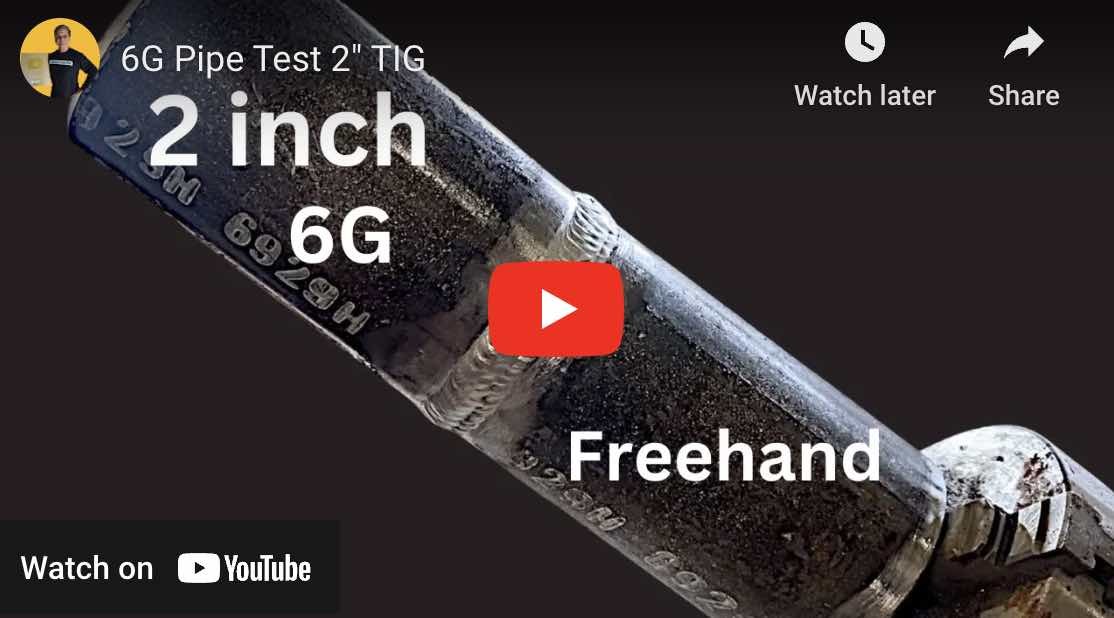6G Tig Welding Certification Tips - Video Showing root pass technique and fill passes
- HOME
- TIG WELDING
- Tig Welding Certification
|
6G 2" TIG ROOT, FILL, CAP, FREEHAND
Tig Welding Pipe
A Tig Welding Certification test on pipe is usually done on a 45 degree angle. Also called the Arkansas Bellhole, but technically known as the 6G position.
Welding codes for administering tig welding certification tests are all very similar in that they all recognize a 6G position test as being the most difficult so they figure if a welder can change body position and hand position to adapt to the different challenge that each side of the pipe gives, then the welder can surely weld all other positions.
"Walking the cup" is a technique often used for tig welding pipe. what it means is that the tig cup is rested on the weld and wiggled or walked like you would walk a 55 gal drum on the floor...along the joint to make the weld.
Anyway, walking the cup is fine for certain situations but not for all. For example, Have you ever taken a tig welding certification test on 1/2" pipe?
Thats pretty small stuff to walk a cup on. ... Its very easy to slip right off.
I would much rather be able to shift gears and freehand when the situation calls for it than to be a one trick pony cup walker....wouldnt you?
When I first learned tig welding, it was on 2" pipe and I freehanded and rested my pinky on the pipe to steady my hand.
Later, I learned to walk the cup on bigger pipe.
But I do remember taking a welding test in a shop where the welding test inspectors were dead set against "cup walkers". Literally every welder who walked the cup that day, walked away without a job...
When in Rome, you are supposed to do as the Romans do...So when you roll up on a job where no one walks the cup, you might need to do as they do just to get the job.
Anyway, I am glad I was able to freehand because, by being allowed to hand around, I learned a new tig welding technique for putting in a root.
What is that technique for tigging in a root pass? Its in the video. But essentially, its just moving the tungsten forward and back instead of wiggling it sideways like you do on a root when you walk the cup.
Moving the electrode forward and back just is not possible if you are walking the cup. But its easy if you use a tig finger heat shield and rest your knuckles on the pipe. You can go sideways, forward and back, or as narrow or wide as you see fit...thats the benefit of not always walking the cup for tig welding certification tests or any other tig pipe joint.
The pipe joint in the video is a 6 inch schedule 80 carbon steel pipe with a 35 degree bevel and only about a 1/32 land.
• The gap is set to about 1/8"
• The filler rod used is 1/8" er70s2
• the electrode is 2% lanth 3/32"
• a #7 cup with a gas lens setup on a #20 water cooled torch.
• a more common setup in the field would be a #17 air cooled torch.
• The root pass was welded using 100 amps
• the hot pass was welded using 100 amps
• After the hot pass was done, I turned up the amperage to 125 and then up to 150 amps after several beads were welded and there was no risk of suck back or melt thru.
I hope you learned something from this video today.
Get a Tig Finger Today. Trust me on this one. exit tig welding certification tips page and learn more about a tig finger heat shield



















